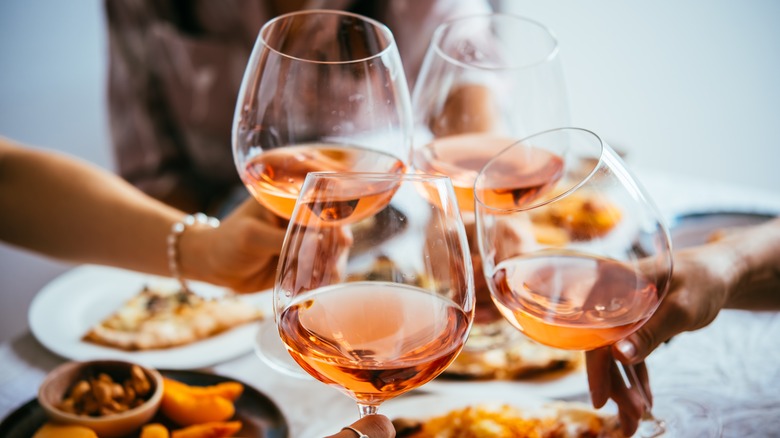Tony Bennett's Favorite Wine Was An Italian Pink Classic
Tony Bennett traveled the world performing for audiences during his epic and lengthy career, yet despite all of that fame (and mileage), he never really ventured too far from his roots. The son of Italian immigrants — born Anthony Dominick Benedetto in Astoria, Queens — frequently returned to the blue-collar neighborhood where he grew up. One of his motivations was to seek out his favorite pasta dish, rigatoni al fileto di pomodoro at Sac's Place. While known to order the meal with red wine on occasion, the late crooner had a different favorite varietal: Italian rosé.
It's unclear what label Bennett preferred, but during a 2014 interview for U.K. online magazine Boisdale Life, the singer requested rosé at a restaurant in London's Dorchester Hotel. The singer actually referred to it as "that pink drink." But he apparently ordered it with enough frequency at the property that the server knew exactly what to bring without any follow-up questions.
It appears Bennett's fondness for rosé dates back to at least the mid-'90s, when he designed a bottle of a sparkling version for Korbel's Artist Series. While best known for his collection of jazz and traditional pop recordings, Bennett was a painter — a medium he was passionate about since he was a child. His Korbel brut rosé label is a rendition of the California winemaker's facility surrounded by a flurry of what could be both snowflakes and wine bubbles.
Rosé all day
If Tony Bennett was living according to the slogan "rosé all day" for decades, he was certainly ahead of the curve. Sure, you see that catchphrase slapped on everything from kitchen towels to tumblers these days, but there was a time when the wine was scorned by consumers. Since rosé doesn't need to be cellared for long compared to other varietals, it's among the cheapest wines to produce and was sometimes a byproduct of the red wine making process. That led to a diminished reputation, and there was a time when the market was flooded with substandard, overly sweet bottles. During the last decade or so, however, millennials have done for rosé what they did for Millennial Pink — give it an enormous popularity boost
A quality rosé should electrify the palate with its crispness and fruity notes while keeping you coming back for another drink thanks to its dryness. The same goes for Italian versions — refreshing, aromatic, slightly acidic. Most producers are located in the northern part of the country. In fact, the area where the Veneto and Lombardy regions meet has been producing rosato since 1896.
If you want to raise a glass in honor of the late, great Bennett, avoid picking a bottle based on the rosé's color if you believe that depicts sweetness level. A darker rosé only indicates the length of grape skin contact, which enhances the final product's tannins. Instead, use our sommelier-ranked list to help you choose your next pink drink.

